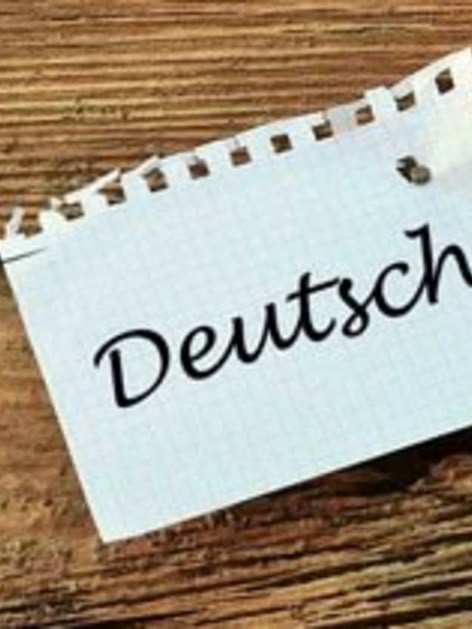Learn German Numbers from 1 to 1000
Numbers in German and their Correct Pronunciation

Pronouncing German numbers can be challenging, especially for those learning German from scratch or as a second foreign language. It's important to pay attention to sounds that don't exist in many other languages, such as the ü in fünf or the ö in zwölf .
It's definitely worth incorporating German videos and podcasts into your learning from the start, or consider taking a language course abroad to immerse yourself in native speakers from the very beginning.
Pronunciation of numbers - selected tips:
- zwei /tsvaɪ/ - the ts sound at the beginning is characteristic and can be a challenge.
- sechs /zɛks/ - note the soft s at the beginning.
- drei /draɪ/ - requires a distinct r , which is usually guttural in German.
| Number | German | Pronunciation (approx.) | English |
| 1 | eins | [ayns] | one |
| 2 | zwei | [tsvye] | two |
| 3 | drei | [dry] | three |
| 4 | vier | [feer] | four |
| 5 | fünf | [fünf] | five |
| 6 | sechs | [zexs] | six |
| 7 | sieben | [zee-ben] | seven |
| 8 | acht | [ahkt] | eight |
| 9 | neun | [noyn] | nine |
| 10 | zehn | [tsayn] | ten |
The next set of numbers to learn is from 11 to 20. This is where things get a bit trickier, but don't worry-there's a simple pattern behind them.
Most of these numbers are formed by taking the first part of the number from three to nine and adding zehn (meaning "ten") to it. The only exceptions are eleven (elf) and twelve (zwölf), which you'll just need to memorize. All the others follow the same rule.
| Number | German | Prounounciation |
| 11 | elf | [elf] |
| 12 | zwölf | [tsv[feer-tsayn] ölf] |
| 13 | dreizehn | [dry-tsayn] |
| 14 | vierzehn | [feer-tsayn] |
| 15 | fünfzehn | [fünf-tsayn] |
| 16 | sechzehn | [zekh-tsayn] |
| 17 | siebzehn | [zeeb-tsayn] |
| 18 | achtzehn | [ahkt-tsayn] |
| 19 | neunzehn | [noyn-tsayn] |
| 20 | zwanzig | [tsvahn-tsig] |
How to form Intermediate Numbers in German?

Numbers between the full tens are formed in German according to a very simple but interesting rule. A significant fact for those familiar with Polish, English, Spanish, and other languages is that when forming intermediate numbers in German, we first say the ones digit and only then the tens digit.
We place the hyphen und between them - and that's it! Let's see how it works with examples:
- 21 = einundzwanzig
- 34 = vierunddreißig
- 52 = zweiundfünfzig
- 87 = siebenundachtzig
- 99 = neunundneunzig
At first, this pattern seems very difficult and will certainly require a lot of practice, but it undoubtedly adds a lot of charm to the German language.
To create numbers over 100, use the rule of gluing words together, which you're already familiar with at this stage. The number of hundreds is determined first, and then the appropriate form for the tens and ones is added:
- 561 = fünfhunderteinundsechzig
- 673 = sechshundertdreiundsiebzig
- 782 = siebenhundertzweiundachtzig
- 894 = achthundertvierundneunzig
- 905 = neunhundertfünf
German Numbers from 21 to 100
First of all, to form the numbers in German, to create the tens, you just have to add -zig at the end of the units. For example, 4 = vier, 40 = vierzig, 5 = fünf, 50 = fünfzig... Be careful: a little adjustment is needed for 3 = drei which becomes 30 = dreißig and 20 which is zwanzig. The numbers are also formed here with the unit + the ten... But the structure is different: digit (unit) + und + unit + zig.
Look at the following examples and this will make more sense to you:
For 53: the structure becomes drei (3, unit) + und + fünf (5 unit) + zig = dreiundfünfzig
For 26: the structure should follow the following pattern: sechs (6 the unit) + und + zwanzig (20, the tens unit - irregular) = sechsundzwanzig
German native speakers usually don't pronounce the "und" properly when they speak fast. In that case, the "und" will sound a bit like "n".
| Number | Alphabetic |
| 21 | einundzwanzig |
| 22 | zweiundzwanzig |
| 23 | dreiundzwanzig |
| 24 | vierundzwanzig |
| 25 | fünfundzwanzig |
| 26 | sechsundzwanzig |
| 27 | siebenundzwanzig |
| 28 | achtundzwanzig |
| 29 | achtundzwanzig |
| 30 | dreißig |
| 31 | einunddreißig |
| 32 | zweiunddreißig |
| 33 | dreiunddreißig |
| 34 | vierunddreißig |
| 35 | fünfunddreißig |
| 36 | sechsunddreißig |
| 37 | siebenunddreißig |
| 38 | neununddreißig |
| 39 | neununddreißig |
| 40 | vierzig |
| 41 | einundvierzig |
| 42 | zweiundvierzig |
| 43 | dreiundvierzig |
| 44 | vierundvierzig |
| 45 | fünfundvierzig |
| 46 | sechsundvierzig |
| 47 | siebenundvierzig |
| 48 | achtundvierzig |
| 49 | neunundvierzig |
| 50 | fünfzig |
| 51 | einundfünfzig |
| 52 | zweiundfünfzig |
| 53 | dreiundfünfzig |
| 54 | vierundfünfzig |
| 55 | fünfundfünfzig |
| 56 | sechsundfünfzig |
| 57 | siebenundfünfzig |
| 58 | achtundfünfzig |
| 59 | neunundfünfzig |
| 60 | sechzig |
| 61 | einundsechzig |
| 62 | zweiundsechzig |
| 63 | dreiundsechzig |
| 64 | vierundsechzig |
| 65 | fünfundsechzig |
| 66 | sechsundsechzig |
| 67 | siebenundsechzig |
| 68 | achtundsechzig |
| 69 | neunundsechzig |
| 70 | siebzig |
| 71 | einundsiebzig |
| 72 | zweiundsiebzig |
| 73 | dreiundsiebzig |
| 74 | vierundsiebzig |
| 75 | fünfundsiebzig |
| 76 | sechsundsiebzig |
| 77 | siebenundsiebzig |
| 78 | achtundsiebzig |
| 79 | neunundsiebzig |
| 80 | achtzig |
| 81 | einundachtzig |
| 82 | zweiundachtzig |
| 83 | dreiundachtzig |
| 84 | vierundachtzig |
| 85 | fünfundachtzig |
| 86 | sechsundachtzig |
| 87 | siebenundachtzig |
| 88 | achtundachtzig |
| 89 | neunundachtzig |
| 90 | neunzig |
| 91 | einundneunzig |
| 92 | zweiundneunzig |
| 93 | dreiundneunzig |
| 94 | vierundneunzig |
| 95 | fünfundneunzig |
| 96 | sechsundneunzig |
| 97 | siebenundneunzig |
| 98 | achtundneunzig |
| 99 | neunundneunzig |
| 100 | (ein)hundert |
100 to 1000
To write the numbers between 101 and 199, just add hundred (hundret in German) in front of the digits and numbers between 1 and 99.
| Number | Pronounciation |
| 100 | einhundert |
| 200 | zweihundert |
| 300 | dreihundert |
| 400 | vierhundert |
| 500 | fünfhundert |
| 600 | sechshundert |
| 700 | siebenhundert |
| 800 | achthundert |
| 900 | neunhundert |
As you can see, it's quite similar to English. The same pattern continues when you move into the thousands.
| Number | Alphabetic |
| 1000 | eintausend |
| 2000 | zweitausend |
| 3000 | dreitausend, and so on... |
German Numbers: 10,000 and Beyond
When it comes to the numbers in German in the ten-thousands, you will utilise the same pattern as with 2-digit numbers. These numbers increase in multiples of ten - for example, zehntausend (10,000), zwanzigtausend (20,000), dreißigtausend (30,000), and so on.
Once a second digit appears, the structure remains consistent. For instance, 87,000 becomes siebenundachtzigtausend ("eighty-seven thousand"). As the numbers grow, they can sound quite long - 87,787 is siebenundachtzigtausendsiebenhundertsiebenundachtzig.
Moving into the hundreds of thousands, the same rule applies using the hundreds. So hunderttausend means 100,000, zweihunderttausend means 200,000, dreihunderttausend means 300,000, and so on.
For even larger numbers in German, here are the key terms you will need to know:
- Million = Million
- Milliarde = Billion
- Billion = Trillion
Ordinal Numbers in German
Forming ordinal numbers in German above 10 is quite simple. Generally, you add the ending -te to the cardinal number up to 19, and -ste from 20 onwards .
Numbers from 11 to 19:
- 11 = elfte (eleventh)
- 12 = zwölfte (twelfth)
- 13 = dreizehnte (thirteenth)
- 14 = vierzehnte (fourteenth)
- 15 = fünfzehnte (fifteenth)
- 16 = sechzehnte (sixteenth)
- 17 = siebzehnte (seventeenth)
- 18 = achtzehnte (eighteenth)
- 19 = neunzehnte (nineteenth)
Numbers over 20:
- 20 = zwanzigste (twentieth)
- 21 = einundzwanzigste (twenty-first)
- 30 = dreißigste (thirtieth)
- 40 = vierzigste (fortieth)
- 50 = fünfzigste (fiftieth)
- 60 = sechzigste (sixtieth)
- 70 = siebzigste (seventieth)
- 80 = achtzigste (eightieth)
- 90 = neunzigste (ninetyth)
- 100 = hundertste (hundredth)
- 1000 = tausendste (thousandth)
Example sentences with ordinal numbers in German:
- Der erste Januar ist ein Feiertag .
= January 1st is a day off from work.
- Meine Wohnung ist im dritten Stock.
= My apartment is on the third floor.
- Das ist das fünfte Mal, dass ich dieses Buch lese.
= This is the fifth time I've read this book.
- Der zehnte Oktober ist der Geburtstag meines Bruders.
= October tenth is my brother's birthday.
In German, the use of periods and commas in numbers is the opposite of English conventions.
- Commas (,) are used as decimal separators (like the English period).
- Periods (.) are used to separate thousands (like the English comma).
So, when writing numbers in German, remember:
Periods = thousands separators
Commas = decimal points
Periods vs. Commas: Writing Numbers the Right Way
Examples:
| English | German | Explanation |
| 1,000 | 1.000 | One thousand — note the period separating thousands |
| 1,000,000 | 1.000.000 | One million |
| 3.14 | 3,14 | Three point one four — comma used as a decimal separator |
| 2,567.89 | 2.567,89 | Two thousand five hundred sixty-seven point eight nine |
Calendar Dates in German
Giving dates is one of the most common uses of numbers. In German, the days of the month are ordinal numbers. For example:
- Der erste Januar = January 1st
- Der fünfte Mai = May 5th
- Der vierundzwanzigste Dezember = December 24 (Christmas Eve)
- Der dritte Oktober = October 3 (German Unity Day)
Dates include not only days and months, but also years. In German, the way years are pronounced changes depending on whether we're talking about years before or after the year 2000. The change in how numbers are pronounced after the year 2000 is common and reflects a more modern form of counting.
Years before 2000 are divided into two parts: the hundreds are pronounced first, followed by the units and tens. It looks like this:
- 1954 to neunzehnhundertvierundfünfzig (literally: nineteen hundred fifty-four)
- 1620 to sechzehnhundertzwanzig (literally: sixteen hundred and twenty)
After the year 2000, years are pronounced as in English, as a full number:
- 2005 is zweitausendfünf (literally: two thousand and five).
- 2019 is zweitausendneunzehn (literally: two thousand and nineteen).
Telling Time in German
Telling hours and minutes is another important skill. Germans use the 24-hour format:
- Es ist zehn Uhr.
= It's ten o'clock.
- Es ist vierzehn Uhr dreißig.
= It's two thirty.
- Das Konzert von Rammstein beginnt um achtzehn Uhr.
= The Rammstein concert starts at 6 p.m.
- Der Film fängt um zwanzig Uhr an.
= The movie starts at 8 p.m.
You can read more about the hours at sita.pl - Hours in German 1 .
Weights and Measures
In everyday life, numbers are used to express weights and measures. For example:
- Ein Liter Milch - One liter of milk
- Zwei Kilo Äpfel - Two kilograms of apples
- Drei Liter Bier - Three liters of beer
- Ein Kilo Haribo-Gummibärchen - One kilogram of Haribo jelly beans
Money in German
In financial transactions, numbers are essential. Examples:
- Das koset fünf Euro.
= It costs five euros.
- Ich habe nur zehn Euro.
= I only have ten euros.
- Das Album von Tokio Hotel kostet zwanzig Euro.
= The Tokio Hotel album costs twenty euros.
- Die Eintrittskarte für das Wacken Open Air Festival kostet fünfzig Euro.
= A ticket to the Wacken Open Air festival costs fifty euros.
Telephone Numbers in German
German telephone numbers are given as a series of consecutive numbers. For example:
- Meine Telefonnummer ist acht, fünf, drei, sechs, zwei, vier, null.
= My phone number is 8536240.
Final Thoughts on German Numbers
In this guide, you've learned the essentials of German numbers - how to count in German, pronounce them correctly, and use them in everyday situations. We also explored more advanced topics like large German numbers and how to express years and dates accurately.
With these basics in hand, you're now ready to apply your knowledge - whether it's for simple counting exercises, understanding prices while shopping, or reading menus in restaurants. Keep practicing, and soon you'll feel confident using German numbers in any real-life context.
German language can be improved during few weeks holiday e.g. in Frankfurt or Munich, Germany.





